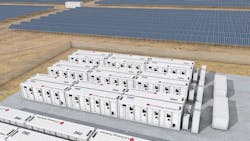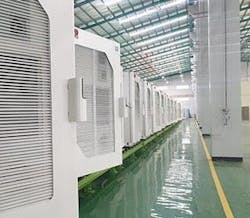U.S. Battery Storage Manufacturers Commit $100B to Production in U.S.
U.S.-based battery storage technology firms are uniting to commit to investing $100 billion toward building and buying American-made energy storage.
This week, the American Clean Power Association announced the $100 billion commitment on behalf of many of the nation’s biggest energy storage companies. The arrival of new tariffs on China and other supply-chain factors has moved energy storage industry leaders in the U.S. to strengthen the domestic supply chain elsewhere, including at home.
U.S. battery storage installation has expanded beyond 26 GW this past year by adding more than 12 GW, according to various reports, and provides the balancing complement to solar energy and microgrid projects. Lithium-ion still dominates the battery chemistry landscape, but researchers and companies are advancing on alternatives such as zinc-based, iron flow and sodium-ion technologies.
“The energy storage industry is providing essential power when needed most while boosting domestic manufacturing and creating jobs across the country,” Jason Grumet, CEO of the American Clean Power Association, said in a statement. The “historic commitment will invest billions of dollars into American communities and position the United States as a manufacturing leader in battery technology that is critical to national and grid security.”
Among the major battery storage technology companies which have announced major manufacturing and supply moves back to the U.S. include Form Energy, Fluence, LG Energy Solution, FREYR and AESC. Last year, the U.S. Department of Energy announced more than $3 billion in funding for 25 projects boosting domestic production of advanced energy storage and battery materials within the U.S. The Biden-era Infrastructure Law allocated nearly $7 billion on strengthen the U.S. battery supply chain.
“Battery energy storage is keeping the lights on and costs low for consumers across the county. Developers are committed to sourcing batteries made in America to deploy this essential energy resource to more Americans for energy stability and cost savings in the face of increasing demand,” said Stephanie Smith, chief operating officer of renewable energy investor Eolian. “As manufacturers begin ramping up domestic supply, streamlining federal and state policies and permitting processes will make the difference in getting this industry moving quickly and competitively.”
Fluence Energy, for instance, has opened or is working to open manufacturing facilities in Utah, Texas, Tennessee and Arizona. LG Energy Solution is ramping up to begin production this year at its Holland, Michigan facility. Form Energy is starting its manufacturing at a plant in Weirton, West Virginia.
“Battery energy storage is key to meeting America’s rapidly expanding electricity needs,” said Craig Cornelius, President and CEO of Clearway Energy Group. “As we deploy energy storage at record pace, this investment reflects the industry’s commitment to building these critical grid infrastructure projects with American-made batteries.”
Although China and Australia still dominate much of global lithium supply, other world leaders in LI production include Chile and Brazil. In the U.S., GeoFrame Energy announced earlier it would break ground on a lithium extraction site in east Texas this summer.
The Battery Storage Race is On Worldwide
Global BESS and Chemistry Movements: Free E-Book at EnergyTech
About the Author
Rod Walton, EnergyTech Managing Editor
Managing Editor
For EnergyTech editorial inquiries, please contact Managing Editor Rod Walton at [email protected].
Rod Walton has spent 17 years covering the energy industry as a newspaper and trade journalist. He formerly was energy writer and business editor at the Tulsa World. Later, he spent six years covering the electricity power sector for Pennwell and Clarion Events. He joined Endeavor and EnergyTech in November 2021.
Walton earned his Bachelors degree in journalism from the University of Oklahoma. His career stops include the Moore American, Bartlesville Examiner-Enterprise, Wagoner Tribune and Tulsa World.
EnergyTech is focused on the mission critical and large-scale energy users and their sustainability and resiliency goals. These include the commercial and industrial sectors, as well as the military, universities, data centers and microgrids. The C&I sectors together account for close to 30 percent of greenhouse gas emissions in the U.S.
He was named Managing Editor for Microgrid Knowledge and EnergyTech starting July 1, 2023
Many large-scale energy users such as Fortune 500 companies, and mission-critical users such as military bases, universities, healthcare facilities, public safety and data centers, shifting their energy priorities to reach net-zero carbon goals within the coming decades. These include plans for renewable energy power purchase agreements, but also on-site resiliency projects such as microgrids, combined heat and power, rooftop solar, energy storage, digitalization and building efficiency upgrades.


